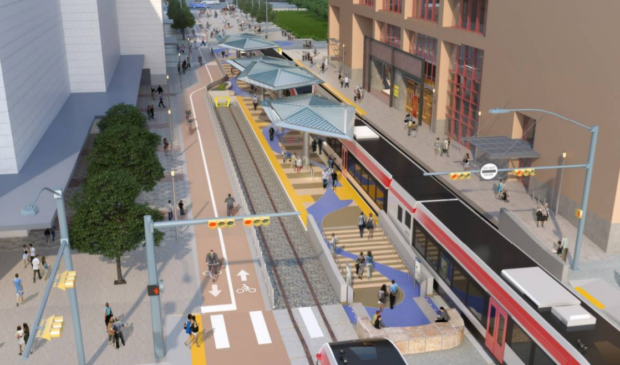Capital Metro cuts back on downtown station plan
Tuesday, January 29, 2019 by
Ryan Thornton A nationwide shortage of skilled labor and a tariff-induced spike in the cost of steel have raised estimated construction costs for Capital Metropolitan Transportation Authority’s downtown rail station. Instead of looking for extra project funding, the agency has decided to simplify the station’s design to remain within the project budget.
Capital Metro’s downtown station project manager, Marcus Guerrero, presented the updated design during the agency’s board of directors meeting Monday afternoon.
While the station’s previous design had featured three separate tracks stretching along East Fourth Street between Red River and Neches streets, the updated design eliminates most of the third track on the north side of the station, except for a section alongside the northern platform. In addition, the new plan reduces the number of shade canopies from seven to five and temporarily removes two of the planned ticketing kiosks which could be added to the plan if more funding is secured. Some landscaping and decorative concrete surrounding the station have also been stripped from the plan.
The MetroRail station is currently both the smallest and the busiest of Capital Metro’s nine commuter rail stations.
Guerrero said the financial challenge provided an opportunity for revisions of the station’s design that the agency believes will ultimately benefit nearby property owners and improve safety.
While the downtown station doesn’t connect to either Republic Square (a transit hub that Capital Metro CEO Randy Clarke called Austin’s “Grand Central Station”) or any of the city’s high-frequency bus routes, the agency sees the station and the adjacent public plaza as key elements of a new vision for southeast downtown. Other major projects surrounding the station include a new vision for Brush Square Park to the north, a potential expansion of the Austin Convention Center to the south and the renewal of Waller Creek to the east.
Traffic to the station should also see a dramatic increase with the addition of Project Connect’s Green Line commuter rail service connecting downtown to Elgin via Manor and Loyola. Capital Metro’s board of directors approved the route in December as part of the Project Connect vision plan, though a construction timeline has not yet been finalized.
Guerrero also reported that Austin City Council provided a waiver of about $1 million in permit and inspection fees plus roughly $13 million in land value via encroachment and easement permits in December. The city also granted an encroachment that will allow Capital Metro to construct a new bridge over Waller Creek. However, Guerrero said a number of permit requests to the city are still pending.
In particular, Guerrero said Capital Metro is currently waiting to see if city staff will repeal their interpretation of city code regarding an issue with water mitigation and drainage at the site. Guerrero said he had previously discussed this issue offline with the board of directors’ newest member, Eric Stratton of Williamson County, who was apparently frustrated by this setback. Stratton lamented that the drainage issue is representative of a larger problem of debilitating bureaucratic roadblocks coming from within various city departments.
“One of the biggest obstacles that I’ve heard since coming on this board is coming not from the elected leadership of the city, but coming from the city departments,” Stratton said. “I believe fully that everyone on this board is committed and that everybody at the City Council level is committed to seeing Project Connect move forward, but my concern is that there are folks that are in the city departments and the bureaucracies underneath that we’re having some issues with. We shouldn’t be having to go through all of these steps, including an appeal for a permit, when we are the Capital Metropolitan Transportation Authority.”
Clarke admitted that moving forward with Project Connect will require more efficient cooperation between government entities.
“We obviously will not be able to do a multibillion-dollar program the way we currently do projects,” he said. “We have to have a very streamlined way to execute for that type of complexity.”
City Council Member Ann Kitchen, however, said city code itself, not staff, is responsible for these obstacles. A staff member doesn’t have the authority to interpret the land development code according to a desired outcome, Kitchen said.
Work on the station will break ground in March and is scheduled to be completed in spring 2021.
Download (PDF, 4.18MB)
Renderings courtesy of Capital Metro.
The Austin Monitor’s work is made possible by donations from the community. Though our reporting covers donors from time to time, we are careful to keep business and editorial efforts separate while maintaining transparency. A complete list of donors is available here, and our code of ethics is explained here.
You're a community leader
And we’re honored you look to us for serious, in-depth news. You know a strong community needs local and dedicated watchdog reporting. We’re here for you and that won’t change. Now will you take the powerful next step and support our nonprofit news organization?






